Structure of the Tree of Life
The Tree of Life (ToL) is a collection of materials documenting the diversity of the world's organisms. The conceptual and navigational structure of the ToL web site is based upon the phylogenetic relationships among the creatures it catalogues and describes.
To learn more about phylogeny and the genetic relatedness of all organisms, please refer to the Phylogenetic Biology pages in the ToL Learning section. The current page provides a brief introduction to some important concepts relevant to the ToL project's structure:
- Hierarchical Relationships Between Groups of
Organisms
containing groups and subgroups - Categories of Tree of Life Pages
branches, leaves, other articles, notes, and treehouses - Links Between Tree of Life Pages
the ToL tree diagram - Exploring the Tree of Life
travelling from the root to the leaves
Hierarchical Relationships Between Groups of Organisms
To the best of our current knowledge, all organisms that are alive today or that have lived on this planet in the past are part of one large, genetically connected group: Life on Earth. The three major groups of living things, Eubacteria, Archaea, and eukaryotes, are thus subgroups of the containing group Life on Earth. Each of these major subgroups of Life is itself divided into a multitude of hierarchically nested subgroups. For example, eukaryotes is the containing group for a variety of groups including plants, animals, and fungi; animals is the containing group for several groups including sponges, cnidarians, and Bilateria; Bilateria is the containing groups for many groups like arthropods, molluscs, and nematodes, etc.

Life on Earth can be divided into a series of hierarchically nested subgroups, starting at the root of all life and ending at the tips in groups that cannot be further subdivided into distinct genetic lineages, e.g., Homo sapiens (humans).
Categories of Tree of Life Pages
The structural backbone of the ToL project consists of leaf and branch pages, which present the scientific core content of the ToL collection. Each of these pages provides a synopsis of the most important characteristics of a particular group of organisms. ToL leaf and branch pages are categorized according to four different page status levels based on their completeness and review status.
- Leaf Pages
 Leaf
pages are ToL pages about the terminal groups, i.e.,
the tips, of the tree of life. What this means is that the group of
organisms that a leaf page is about is not further subdivided into
independent genetic lineages or subgroups. ToL leaf pages are most
often pages about individual species; however, leaf
pages are not defined by the rank of a given group; rather,
if a species is divided into subspecies, varieties, or strains, and
if ToL authors decide to devote separate ToL pages to these subgroups,
then the pages for the subspecies, varieties, or strains, would be
the leaf pages. Here are some examples of ToL leaf pages: The
Vampire Squid, The
Tailed Frog, The
Salamanderfish of Western Australia, Bembidion
levettei (a carabid beetle), Pelegrina
aeneola (a jumping spider).
Leaf
pages are ToL pages about the terminal groups, i.e.,
the tips, of the tree of life. What this means is that the group of
organisms that a leaf page is about is not further subdivided into
independent genetic lineages or subgroups. ToL leaf pages are most
often pages about individual species; however, leaf
pages are not defined by the rank of a given group; rather,
if a species is divided into subspecies, varieties, or strains, and
if ToL authors decide to devote separate ToL pages to these subgroups,
then the pages for the subspecies, varieties, or strains, would be
the leaf pages. Here are some examples of ToL leaf pages: The
Vampire Squid, The
Tailed Frog, The
Salamanderfish of Western Australia, Bembidion
levettei (a carabid beetle), Pelegrina
aeneola (a jumping spider).- Branch Pages
 Branch
pages are ToL pages about groups of organism that can be
divided into subgroups representing distinct genetic lineages. For
example, a branch page may be about a group of related species, or
it may be about a genus, a family, or a group of related families.
ToL branch pages always feature a phylogenetic tree or a list of taxa
providing an overview of the subgroups included in the group that
the branch page is about. Here are some examples of ToL branch pages:
eukaryotes,
sea cucumbers,
terrestrial
vertebrates, Agaricomycotina
(a group of fungi), dobsonflies.
Branch
pages are ToL pages about groups of organism that can be
divided into subgroups representing distinct genetic lineages. For
example, a branch page may be about a group of related species, or
it may be about a genus, a family, or a group of related families.
ToL branch pages always feature a phylogenetic tree or a list of taxa
providing an overview of the subgroups included in the group that
the branch page is about. Here are some examples of ToL branch pages:
eukaryotes,
sea cucumbers,
terrestrial
vertebrates, Agaricomycotina
(a group of fungi), dobsonflies.
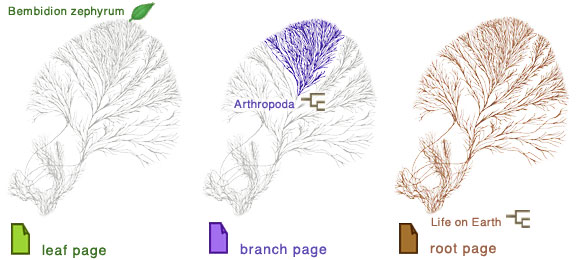
The scientific core content of the ToL project is presented on leaf and branch pages. Leaf pages represent the tips of the tree of life, while branch pages represent groups containing several related subgroups. The Root Page of the ToL is a special kind of branch page, providing information on the characteristics of all Life on Earth and the relationships among the major lineages of organisms.
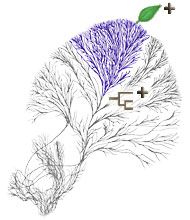
Articles, notes, and treehouses are attached to leaf and branch pages, which provide the structural backbone for the ToL project.
In addition to the scientific core content presented on branch and leaf pages, the ToL project features other scientific articles, notes, and treehouses, which are attached to one or more leaves or branches of the tree of life.
- Articles
- Other Articles provide in-depth scientific information that is beyond the scope of the synopses provided on ToL leaf and branch pages. They may include more detailed descriptions of structure, ecology, behavior, life cycles, discussions of phylogenetic relationships, etc. While leaf and branch pages are generally authored by systematists and phylogenetic biologists, other articles which are linked to the structural backbone of the ToL provide biologists from any subdiscipline with the opportunity to present their research to the public. Like leaf and branch pages, other ToL articles are assigned a page status level based upon their completeness and review status. Here are some examples of linked ToL articles: Tyrannosaurid Systematics, Characteristics of Annelida, Embryology and Development of Aspidogastrea, Phylogeny and Classification of Amniotes.
- Notes
- Notes also provide additional scientific information, but they are generally shorter than articles. There are very few requirements with respect to the content of ToL notes. They may consist of brief accounts of characteristics, short summaries, commentaries, collections of media files (e.g., image or movie galleries), taxonomic information, or identification tools for a given group of organisms. Notes are reviewed by ToL editors before publication, but unlike ToL articles they are not subject to the page status system. Here are some examples of ToL notes: Cranchiid Buoyancy, Movies of Jumping Spider Courtship, Key to the Species of Amphilinidea, Amoebae: Protists Which Move and Feed Using Pseudopodia.
- Treehouses
- Treehouses are designed for children or the young at heart. Unlike ToL scientific contributors, authors of treehouses do not have to be professional scientists. Anybody with an interest in publishing their insights and experiences about organisms can become a treehouse builder. Treehouses are reviewed by ToL editors before publication, but they are not subject to the page status system.
Links Between ToL Pages
In order to put the information about individual groups in a phylogenetic context, ToL branch pages feature a tree diagram (or a list of subgroups if relationships among subgroups are unknown). Tree diagrams provide an overview of the phylogenetic relationships among subgroups. For example, the tree diagram of the beetle page (Coleoptera) looks like this:
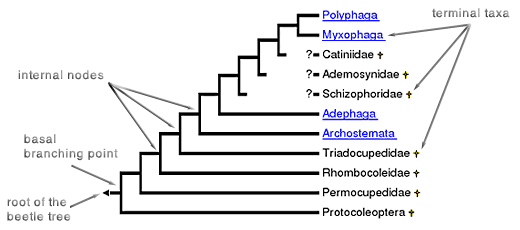
The tree diagram on the beetle (Coleoptera) page showing the relationships between the major beetle subgroups.
The basal branching point in the Coleoptera tree represents the ancestor of all beetles. This ancestor diversified over time into several descendent subgroups, which are represented as internal nodes (branching points) and terminal taxa at the tips of the beetle tree. Beginning at the root on the left, the diagram shows that the ancestral beetle lineage gave rise, on the one hand, to members of the extinct Paleozoic group Protocoleoptera, and on the other to the ancestor of the remaining beetles. This ancestor in turn split into a species that gave rise to the extinct family Permocupedidae, and another that gave rise to the remainder of the beetles. Further splitting of ancestral species would lead us to the terminal taxa in the diagram, where we see Polyphaga and Myxophaga on adjacent branches. The ancestral species of these two groups split in two to give rise to one species that was the ancestor of the Polyphaga, and another species that was the ancestor of the Myxophaga. Even though it isn't shown on this diagram, the splits implied in this tree probably happened in the Permian period, before the time of the dinosaurs.
Please refer to Interpreting the Tree Diagram or Taxon List on a Tree of Life Page for more information about ToL tree diagrams.
Moving Up the Tree of Life
Terminal taxon names that are underlined and printed in blue represent links to ToL pages about a particular subgroup. By clicking on the names of these groups, ToL visitors can thus move up to a branch higher in the tree of life. For example, in the beetle tree, one can move up to the branch pages of the beetle subgroups Polyphaga, Myxophaga, Adephaga, and Archostemata. On each of these pages, there will then be another tree diagram with links to subgroups leading further up the branches of the tree of life. In this way, one can move from Coleoptera to Adephaga to Carabidae and then to Gehringia olympica, which is a beetle species, representing a leaf on the tree of life.

Terminal taxon links in ToL tree diagrams let visitors move up the branches of the tree of life, all the way to leaf pages.
Moving Down the Tree of Life
The root of the beetle tree (![]() )
connects the beetles to their containing group, the Endopterygota (insects
with complete metamorphosis). ToL visitors can click on this root to move
down the tree of life to the Endopterygota page. On the Endopterygota
page, there's a tree diagram showing the relationships between the Endopterygota
subgroups, including the beetles (Coleoptera). Clicking on the root of
the Endopterygota tree will take visitors further down to the Neoptera
page, and clicking on the root of the Neoptera tree will lead down one
step further to the Pterygota page. If one were to keep on clicking on
the roots of ToL branch pages, one would eventually get to the root page
for the entire project representing Life on Earth, the ultimate containing
group for all organisms.
)
connects the beetles to their containing group, the Endopterygota (insects
with complete metamorphosis). ToL visitors can click on this root to move
down the tree of life to the Endopterygota page. On the Endopterygota
page, there's a tree diagram showing the relationships between the Endopterygota
subgroups, including the beetles (Coleoptera). Clicking on the root of
the Endopterygota tree will take visitors further down to the Neoptera
page, and clicking on the root of the Neoptera tree will lead down one
step further to the Pterygota page. If one were to keep on clicking on
the roots of ToL branch pages, one would eventually get to the root page
for the entire project representing Life on Earth, the ultimate containing
group for all organisms.
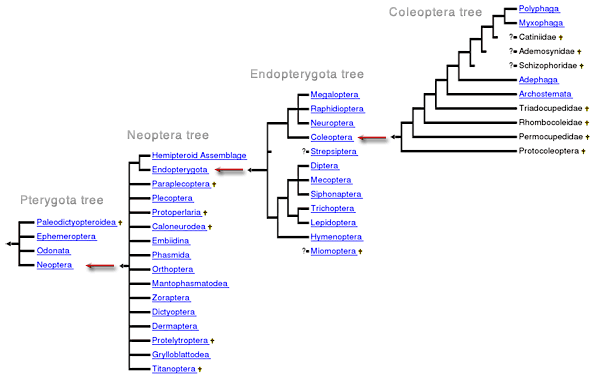
Root links in ToL tree diagrams let visitors travel down the branches of the tree of life to ever more inclusive containing groups.
Exploring the Tree of Life
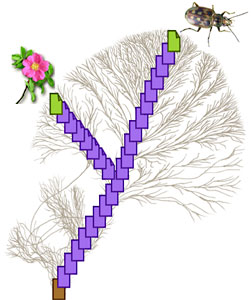
Links between ToL pages let visitors explore the evolutionary tree of life from the bottom up or from the top down.
The tree diagram or taxon list on each ToL branch page is linked to the trees/lists of the pages for related groups. All ToL pages taken together therefore present current ideas about the structure of the entire evolutionary tree of living things (at least to the extent that the project has been developed so far). Following the links up and down the tree, you can wander along the branches, exploring the diversity of many different kinds of organisms, while at the same time being reminded of the genetic connectedness of all of Life.
You may begin you journey at the root of all Life on Earth, travelling up the tree through levels of ever less inclusive groups, all the way up to the leaf pages of individual species or subspecies. Or you may start your exploration on a leaf page, following the link to its containing group and then moving through ever more inclusive containing groups, all the way down to the root.
In addition to the tree diagram or taxon list, ToL pages feature links to other organisms in the Explore Other Groups menu in the right sidebar. For more information about all the different navigation options, please refer to the Navigating the ToL page.
 Go to quick links
Go to quick search
Go to navigation for this section of the ToL site
Go to detailed links for the ToL site
Go to quick links
Go to quick search
Go to navigation for this section of the ToL site
Go to detailed links for the ToL site